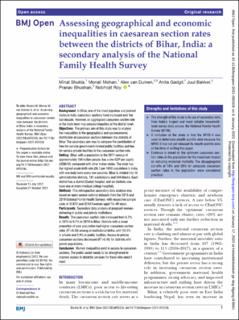| dc.description.abstract | Background In Bihar, one of the most populous and poorest states in India, caesarean sections have increased over the last decade. However, an aggregated caesarean section rate at the state level may conceal inequities at the district level.
Objectives The primary aim of this study was to analyse the inequalities in the geographical and socioeconomic distribution of caesarean sections between the districts of Bihar. The secondary aim was to compare the contribution of free-for-service government-funded public facilities and fee-for-service private facilities to the caesarean section rate.
Setting Bihar, with a population in the 2011 census of approximately 104 million people, has a low GDP per capita (US$610), compared with other Indian states. The state has the highest crude birth rate (26.1 per 1000 population) in India, with one baby born every two seconds. Bihar is divided into 38 administrative districts, 101 subdivisions and 534 blocks. Each district has a district (Sadar) hospital, and six districts also have one or more medical college hospitals.
Methods This retrospective secondary data analysis was based on open-source national datasets from the 2015 and 2019 National Family Health Surveys, with respective sample sizes of 45 812 and 42 843 women aged 15–49 years.
Participants Secondary data analysis of pregnant women delivering in public and private institutions.
Results The caesarean section rate increased from 6.2% in 2015 to 9.7% in 2019 in Bihar. Districts with a lower proportion of poor population had higher caesarean section rates (R2=0.45) among all institutional births, with 10.3% in private and 2.9% in public facilities. Access to private caesarean sections decreased (R2=0.46) for districts with poorer populations.
Conclusion Marked inequalities exist in access to caesarean sections. The public sector needs to be strengthened to improve access to obstetric services for those who need it most. | en_US |

